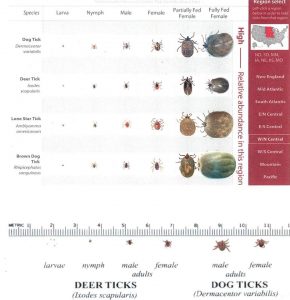
The ticks are out and about!!! According to the Companion Animal Parasite Council (CAPC), Lyme disease is predicted to be highly problematic for 2017. They recommend that dogs be given year round tick prevention. This reduces infestations on the pet, reduces the number of ticks in the environment around the home, and prevents establishment of brown dog tick populations in the home. It also important because ticks transmit a wide variety of disease agents to pets and people and are active throughout the year, tick control must be practiced year round to protect the health of the pet.
As tick populations are on the rise, so are tick-borne disease infections in humans and dogs. Lyme disease is the most well-known tick-borne disease but there are newer diseases emerging. Powassan encephalitis, caused by the Powassan virus (POWV), is a viral infection transmitted by ticks. Symptoms manifest within 7–10 days and include fever, headache, partial paralysis, confusion, nausea and even coma.
Another disease ticks can transmit is called Ehrlichiosis. Ehrlichiosis is a nationwide disease with most cases being reported during April–September. The most common symptoms include headache, muscle aches, and fatigue.
There are a wide range of tick prevention products available. Products come in topical or oral form. The most effective medications are sold by your veterinarian. We highly recommend not using “home” remedies found on the internet. Peppermint oil is being purported as a way to remove ticks. Peppermint oil makes ticks regurgitate their gut contents into you or your pet before it dies. This actually increases you or your dog’s risk of contracting a tick-borne disease. It is important to ask your veterinarian which prevention is best for your dog.
Don’t forget our feline friends! Outdoor cats are also at risk for ticks, so make sure your whole family is protected.
Common ticks in Iowa:
Deer ticks are vectors for several diseases of animals, including humans (Lyme disease, babesiosis, anaplasmosis, Powassan encephalitis, etc.) Deer ticks are found in many locations where their preferred host, the white-tailed deer, dwells. They tend to live in wooded areas and along trails in forests.
Wood ticks are a species of tick that is known to carry bacteria responsible for several diseases in humans, including Rocky Mountain Spotted Fever and tularemia. They are commonly found in highly wooded, shrubby, and long grass areas. Tick numbers can be reduced in your own back yard by cutting the grass, which creates a low humidity environment which is undesired by ticks.
Brown dog ticks are vectors of the diseases in dogs called canine ehrlichiosis (Ehrlichia canis) and canine babesiosis (Babesia canis). These ticks can also live inside homes and kennels.
